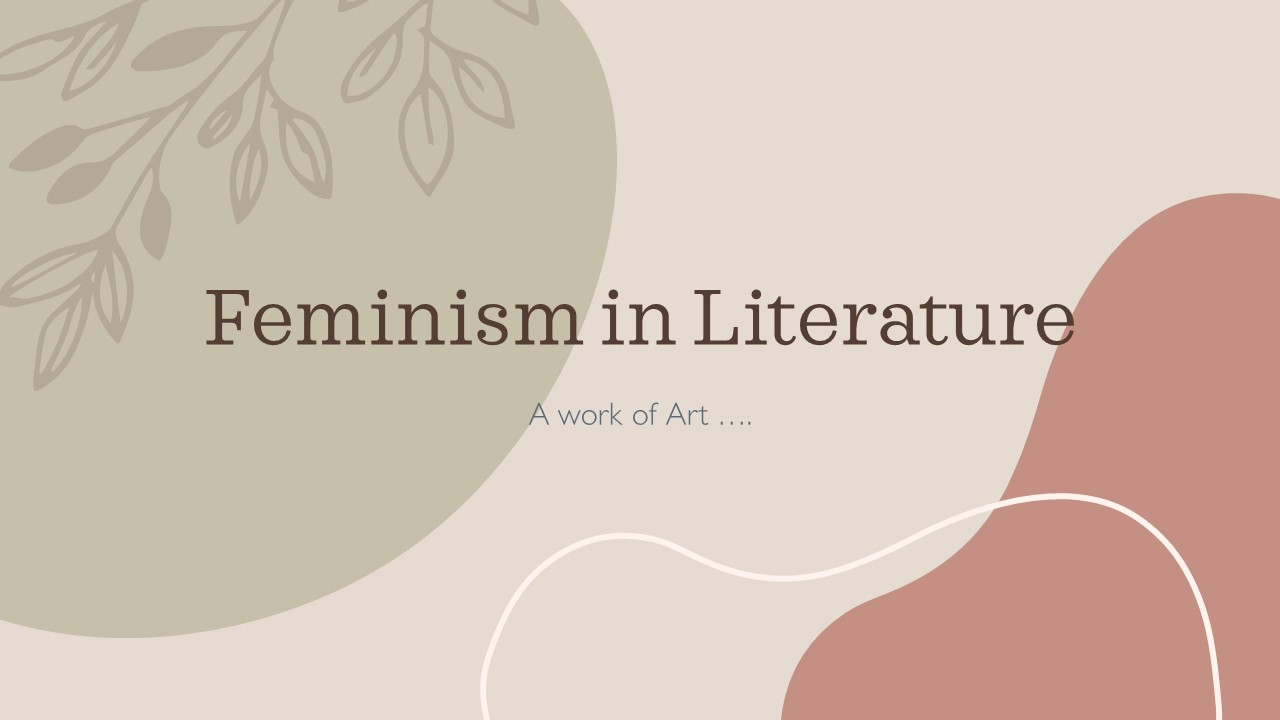Feminism in Literature - PowerPoint PPT Presentation
Title:
Feminism in Literature
Description:
The issue of Feminism in English Literature is not new but due to patriarchal society, it has been suppressed and overlooked. The existence of inequalities between men and women are not natural but social taboo. – PowerPoint PPT presentation
Number of Views:10
Title: Feminism in Literature
1
Feminism in Literature
- A work of Art .
2
Contents
BACKGROUND
DEVELOPMENT
CONCLUSION
3
Background
- The issue of Feminism in English Literature is
not new but due to patriarchal society, it has
been suppressed and overlooked. The existence of
inequalities between men and women are not
natural but social taboo. One may ask Mary
Wollstonecraft, one of the authors who wrote
about feminism, advocates in her A Vindication of
the Rights of Women (1792) that women must be
treated equally because they have to play a
crucial and vital role in society especially
bringing up children. - he attacks male thinker and scholar like
Rousseau who argued that women did not need
education but she supported education as a means
of womens improvement. - Like her American activist, Margaret Fuller one
of the famous female writers of the 19th century,
in her Women in the Nineteenth Century (1845)
believed that education is the means of
emancipation for women and her keys planks are
education, employment and political. - While in the twentieth century, Virginia Woolf,
a modernist and female Victorian author, explored
gender relations in her A Room of Ones
Own (1929) and Three Guineas (1938). She
vehemently argued that patriarchal education
systems and reading practices prevent women
readers from reading as women.
4
- It is also remarkable when she remarks a woman
must have money and a room of her own if she to
write fiction. She advocates for the liberation
of women, financially independence and right to
reveal feelings and experiences through words. - Whereas Simone De Beauvoir favours that there
is no essence of the woman and a woman is
constructed by men. As she states it in her
feminism manifesto The Second Sex (1949) One is
not born a woman but become one. - The exploitation, discrimination and the crisis
of womens identification faced by women in the
society have questioned by female writers,
activists, and critics. - In relation to literature, the feminism movement
has focused on the role played by literature to
bring out gender discrimination, domestic
violence, and inequality on the forefront.
5
Main Characters
- Mary Wollstonecraft
- Margaret Fuller
- Virginia Woolf
- Simone de Beauvoir
- British writer and philosopher
- American journalist and editor
- English writer
- French philosopher and writer
6
DEVELOPMENT
7
The concept of Feminism Movement got proper
prominence and importance in the 1960s. Earlier,
feminism was limited to some female writers only
but the increased number of female writers and
the representation of women characters in fiction
world drew large attention in the literature. The
evolution of the feminist movement in the
literature as followsFirst Wave
Feminism mainly concerned with the treatment of
women in the male-dominated society. The major
works which raised the issues of feminism during
this phase are Mary Ellmans Thinking about
Women (1968), Kate Millets Sexual
Politics (1969) and Germaine Greers The Female
Eunuch (1970). Many important works of the male
writers have been studied in order to analyze the
attitude of male towards women and
society.Second Wave Feminism is concerned with
women writings include Ellen Mores Literary
Women (1976), Elaine Showalters A Literature of
Their Own (1970), Nina Bayms Womens
Fiction (1978) , Sandra Gilbert and Susan
Gubars The Mad Woman in the Attic (1979), and
Margaret Homans Women Writers and Poetic
Identity (1980).First Wave Feminism mainly
concerned with the treatment of women in the
male-dominated society. The major works which
raised the issues of feminism during this phase
are Mary Ellmans Thinking about
Women (1968), Kate Millets Sexual
Politics (1969) and Germaine Greers The Female
Eunuch (1970). Many important works of the male
writers have been studied in order to analyze the
attitude of male towards women and
society.Second Wave Feminism is concerned with
women writings include Ellen Mores Literary
Women (1976), Elaine Showalters A Literature of
Their Own (1970), Nina Bayms Womens
Fiction (1978) , Sandra Gilbert and Susan
Gubars The Mad Woman in the Attic (1979), and
Margaret Homans Women Writers and Poetic
Identity (1980).Elaine Showalters A Literature
of Their Own published in 1970. This phase
chiefly explores the relationship between female
and literature
8
CONCLUSION
- Feminism in literature
- Feminism questions the long-standing, dominant,
male interpretations, phallocentric ideology and
patriarchal attitude. It concerned with varied
aspects of feminism. - As Showalter sums up, English feminist
criticism, essentially Marxist, stressed
oppression, French feminist criticism, especially
psychoanalyst, stresses oppression. However, all
have become gynocentric. - Feminism criticism also concerned with womens
language and they need to cultivate linguistic
and stylistic devices that can spontaneously
express feminine sensibility and individuality. - Texts like Woolfs Mrs. Dalloway, Kate
Chopins The Awakening (1899) and Alice
Walkers The Color Purple (1982) are
women-centric and unfolded the new womens
perspectives to analyze in the patriarchal
society and distort all kinds of inequality and
dependency on male counterparts. - Today women writers write enormously and
expressed their sensibilities through their
writings to enrich the substance of English
literature. Feminism has empowered the confidence
of women and provided the individuality
identification in the patriarchal society.
9
thank you






























![[DOWNLOAD]⚡️PDF✔️ Hélène Cixous: Dreamer, realist, analyst, writing PowerPoint PPT Presentation](https://s3.amazonaws.com/images.powershow.com/10047870.th0.jpg?_=20240605039)
![[DOWNLOAD]⚡️PDF✔️ Hélène Cixous: Dreamer, realist, analyst, writing PowerPoint PPT Presentation](https://s3.amazonaws.com/images.powershow.com/10048516.th0.jpg?_=202406051111)